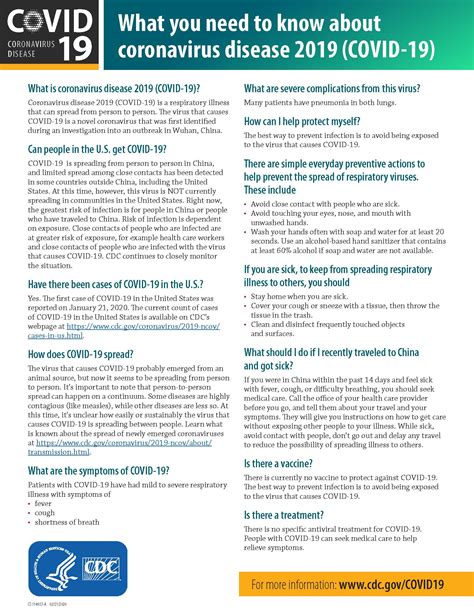CDC Facts You Need

Introduction to CDC Facts
The Centers for Disease Control and Prevention (CDC) is a United States federal agency that plays a critical role in protecting public health and safety. With its headquarters in Atlanta, Georgia, the CDC is part of the Department of Health and Human Services (HHS) and is one of the major operating components of the HHS. The agency’s main goal is to protect the public health and safety through the control and prevention of disease, injury, and disability in the US and internationally. In this article, we will explore some of the key facts you need to know about the CDC.
CDC History and Structure
The CDC was established on July 1, 1946, and its initial focus was on malaria control. Over the years, the agency has expanded its scope to include a wide range of health-related issues, including infectious diseases, environmental health, and emergency preparedness. The CDC is headed by a Director, who is appointed by the President and confirmed by the Senate. The agency is organized into several centers, institutes, and offices, each with its own specific area of focus.
CDC Roles and Responsibilities
The CDC plays a critical role in protecting the public health and safety through a variety of activities, including: * Disease surveillance and investigation: The CDC monitors and investigates outbreaks of infectious diseases, such as influenza, tuberculosis, and foodborne illnesses. * Research and development: The CDC conducts research on new and emerging health threats, and develops new tests, treatments, and vaccines to combat these threats. * Public health education and awareness: The CDC provides information and guidance to the public on a wide range of health-related topics, including disease prevention, healthy behaviors, and emergency preparedness. * Global health security: The CDC works with international partners to strengthen global health security and prevent the spread of infectious diseases across borders.
CDC Initiatives and Programs
The CDC has launched several initiatives and programs to address specific health-related issues, including: * Antibiotic Resistance Threats in the United States: This initiative aims to combat antibiotic resistance by promoting appropriate use of antibiotics and developing new tests and treatments for antibiotic-resistant infections. * CDC’s Global Health Security Agenda: This program aims to strengthen global health security by enhancing laboratory capacity, surveillance, and response to infectious disease outbreaks in low- and middle-income countries. * CDC’s Climate and Health Program: This program aims to understand and address the health impacts of climate change, including heat-related illnesses, vector-borne diseases, and waterborne diseases.
CDC Data and Statistics
The CDC collects and analyzes data on a wide range of health-related topics, including: * Morbidity and Mortality Weekly Report (MMWR): This report provides up-to-date information on infectious diseases, outbreaks, and other health-related issues in the US and internationally. * National Health and Nutrition Examination Survey (NHANES): This survey provides data on the health and nutritional status of the US population, including prevalence of chronic diseases, nutritional deficiencies, and health behaviors. * National Vital Statistics System (NVSS): This system provides data on births, deaths, and other vital events in the US, including cause of death, infant mortality, and life expectancy.
| Category | Indicator | US Data (2020) |
|---|---|---|
| Infectious Diseases | Tuberculosis cases | 8,916 |
| Chronic Diseases | Diabetes prevalence | 34.2 million |
| Environmental Health | Air quality index | 45.6 |
📝 Note: The data and statistics provided are subject to change and may not reflect the most up-to-date information.
CDC Partnerships and Collaborations
The CDC partners with a wide range of organizations, including state and local health departments, healthcare providers, and community-based organizations, to achieve its mission. Some of the key partnerships and collaborations include: * World Health Organization (WHO): The CDC works with the WHO to address global health security threats and promote international cooperation on health issues. * US Department of State: The CDC works with the US Department of State to enhance global health security and promote US foreign policy objectives. * Non-governmental organizations (NGOs): The CDC partners with NGOs to support global health initiatives and promote community-based health programs.
In summary, the CDC plays a critical role in protecting public health and safety through a wide range of activities, including disease surveillance and investigation, research and development, public health education and awareness, and global health security. The agency’s initiatives and programs, such as antibiotic resistance threats, global health security agenda, and climate and health program, aim to address specific health-related issues and promote healthy behaviors. The CDC’s data and statistics provide valuable insights into the health status of the US population, and its partnerships and collaborations with international organizations, state and local health departments, and community-based organizations help to achieve its mission.
What is the main goal of the CDC?
+
The main goal of the CDC is to protect the public health and safety through the control and prevention of disease, injury, and disability in the US and internationally.
What are some of the key initiatives and programs of the CDC?
+
Some of the key initiatives and programs of the CDC include antibiotic resistance threats, global health security agenda, and climate and health program.
How does the CDC collect and analyze data on health-related topics?
+
The CDC collects and analyzes data on health-related topics through various surveys, reports, and systems, including the Morbidity and Mortality Weekly Report (MMWR), National Health and Nutrition Examination Survey (NHANES), and National Vital Statistics System (NVSS).